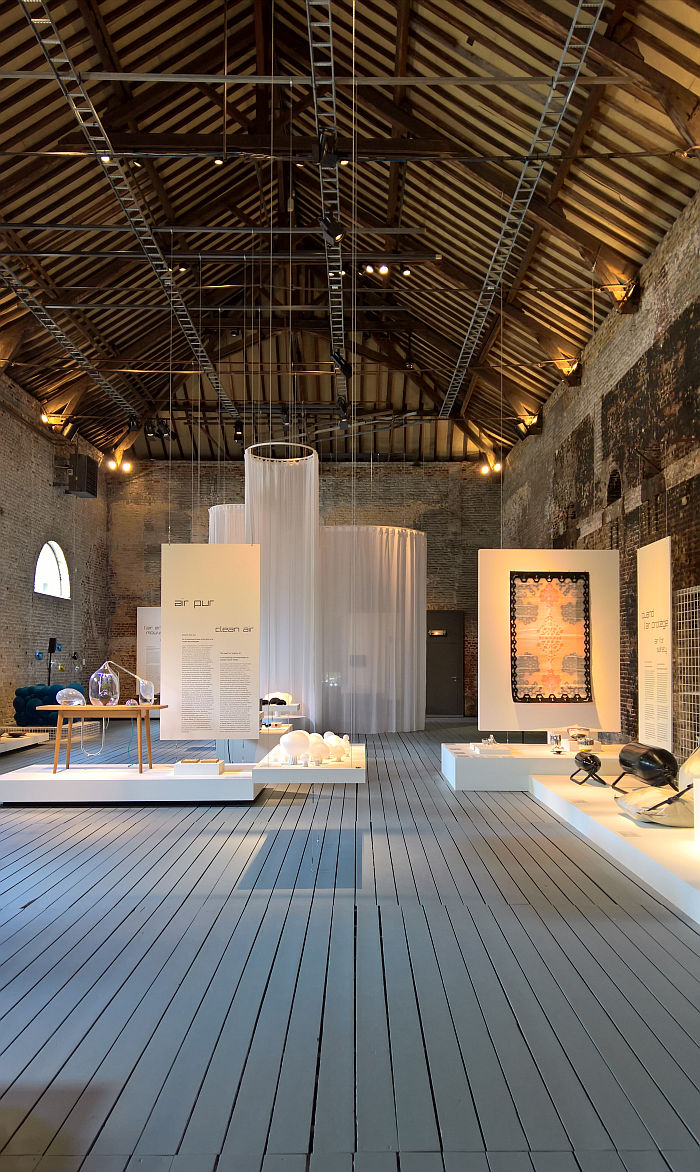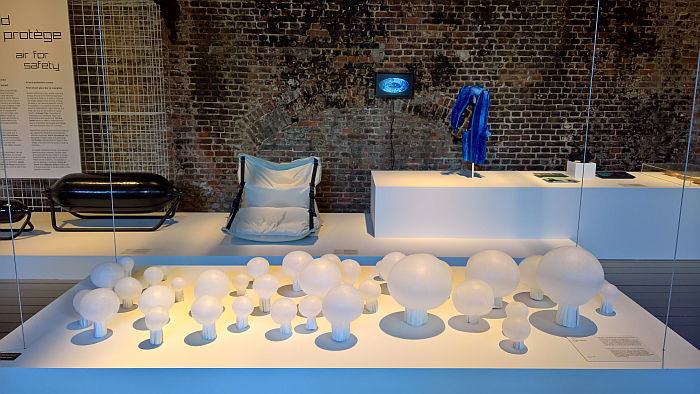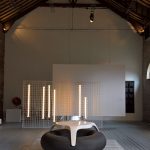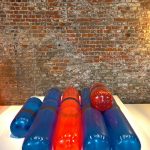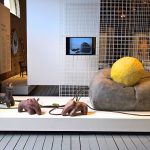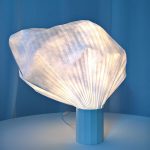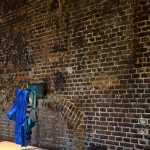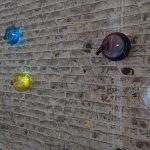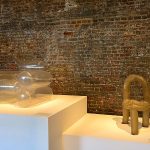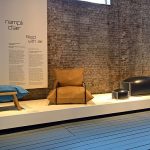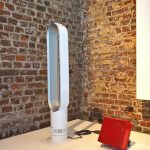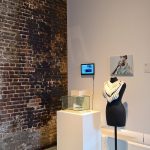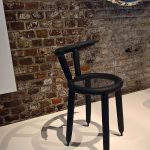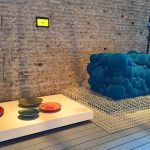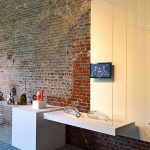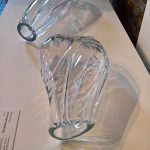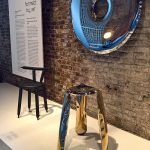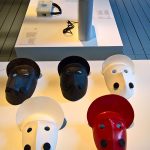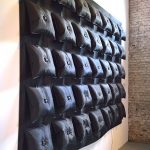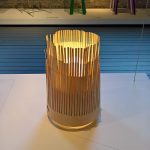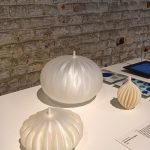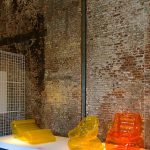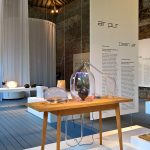Design on Air at the CID – centre d’innovation et de design au Grand-Hornu, Hornu
According to the Greek philosopher Anaximenes of Miletus, air is the source of everything.
And whereas in the intervening 2500 years we have come to better understand the true nature, character and properties of air, as the exhibtion Design on Air at the Centre d’innovation et de design Grand-Hornu illustrates, air remains a very potent, stimulating, and protean creative force.
Omnipresent yet absent, perceptible yet intangible, air was not only – alongside fire, water and earth – one of the classic four elements of ancient Greece, but is also found amongst the fundamental elements/energies of numerous early civilisations. However, while air’s importance was presumed from the very beginnings of human society, it wasn’t until the late 18th century that air’s importance was understood: primarily its role in sustaining all (aerobic) life on earth. Parallel to better understanding air’s chemical character, over the centuries and decades since Anaximenes’ musings we’ve also come to better understand air’s physical properties, properties which we’ve learned to harness, becoming in the process ever more adept at employing air as a tool, a conduit or even a material in its own right.
And it is just such a directed, practical, harnessing and employing of air which forms the central core of Design on Air.
Be that air as a material as discussed in the chapter Filled With Air with its focus on inflatable furniture such as, and amongst other projects, Quasar Khanh’s Aerospace collection from 1968, K. Göhling’s 1970 inflatable tube Lounge Chair, whereby K. Göhling is, we presume, Klaus Göhling, an early pioneer of large format inflatable installations, and on to more modern interpretations including Victor Alge’s 2018 Alces Alces, a chair crafted from an inflated moose parchment, and which, as we previously noted, although interesting, and certainly sustainable, is clearly not a project for all you veggies and vegans out there.
Similarly, Formed by Air considers objects filled with air to create stable, functional forms, albeit through processes a little more involved than “standard” inflation and including projects as diverse as Jasper Morrison’s gas injection moulded Air Chair for Magis, Oskar Zieta’s FIDU steel inflation process as exemplified through the Plopp stool and Rondo mirror or Marcel Wanders’ Sparkling Chair/Still Chair for Magis, a work which also stands as a reminder that the inspiration air provides a designer may not be enough to blow away other considerations: Wanders’ original plan was to have a chair crafted, in effect, from PET bottles inflated by high pressure gas. To assure the durability of the object, presumably with safety concerns in mind, Magis however opted for thicker plastic and no gas. And therefore an object which looks like the original concept, but isn’t. And a decision which underscores the interplay between designer and manufacturer in the realisation of a project. And a decision, one assumes, Marcel Wanders wasn’t overjoyed with: or as he himself phrases it ☹
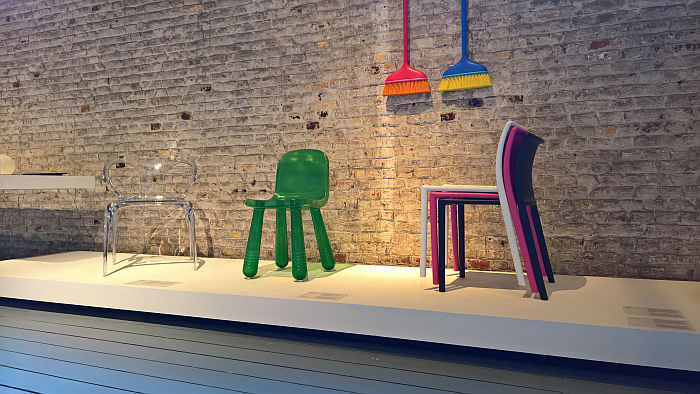
Mago by Stefano Giovannoni, Sparkling Chair/Still Chair by Marcel Wanders, Air Chair by Jasper Morrison, all for Magis & Ava bridge chair by Zhong Song Wen for Roche Bobois, as seen at Design on Air, Centre d’innovation et de design au Grand-Hornu
Air and safety are placed in much more positive, 😃, contexts in the chapter, Air for Safety, with air discussed both as it is used directly to provide for safety, including, for example, Andreas Finke’s Under the Skin pneumatic protective sport clothing or Nedda El-Asmar’s double walled glassware which employs air’s poor heat conduction to protect against hot liquids, but also more conceptually including Jeff Rutten’s use of nautical mooring fenders for his Albatroz outdoor seating collection.
Moving away from air as a material, air as a facilitator is explored in Moving Air, be that directly through Maarten Baas’ 2007 Clay Fan or James Dyson’s am07 fan or more indirectly by, and amongst other works, Michael Graves’ and Richard Sapper’s Alessi kettles with their musical announcement that your water is boiling. While in a much more metaphysical mood In the Air considers bubbles, balloons et al as, if you will, attempts to trap the ephemeral, intangibility of air in objects, and expressed through works such as, and amongst many others, Hideki Yoshimoto’s Rise which creates the illusion of bubbles rising from a solid block of epoxy resin, nendo’s Blown fabric polyester lighting or Inga Sempé’s Lampe Vapeur for Moustache with their ballooning pleated Tyvek shades.
Alongside all the celebration of air, Design on Air also discusses some of air’s current troubles: for important, critical, as air is for all life on earth, we as a species have long neglected air, given no thought to that which we put into it, with the inevitable consequence that air pollution is rising, the air that we breath far from being that which sustains all (aerobic) life on earth is increasingly becoming a hazard for life, and clean air is in danger of becoming a commodity akin to potable water or uncontaminated soil.
Further evidence, were it needed, that as a species we really are no where near as clever as we like to claim we are.
And a reality discussed through objects such as Cleasson Koivisto Rune’s Sense air purifier for Blueair, Julian Melchiorri’s synthetic, air purifying, Silk Leaf project or a number of face masks projects, perhaps most dramatically Philippe Tabet and Sergio Boldrin’s Medico dell’Aria full face smog masks in the Venetian mask tradition. And projects which tend to confirm that the best option, as ever, is prevention not cure, not to poison our air, something admonished in Superflux’s Buggy Air, an air quality sensor designed specifically for prams and buggies, thus underscoring the quality of the air we are passing on to future generations. We needn’t. But only a clever species would realise that and react accordingly.
In 1925 Marcel Breuer predicated that in the future we’d all be sitting on “resilient columns of air”
We’re not.
But are very often sitting on air, or more accurately put, on that which air enables us to form.
And wandering through Design on Air one is made very clear that we only have a very limited number of options for harnessing and utilising air, essentially air can be trapped or caused to move: How one traps it, how one causes it to move, and what one does with that entrapment and movement being decisive. And as Design on Air very neatly and satisfyingly explains, the restricted number of options for harnessing and utilising air in no way restricts creatives: ever new ways being found for utilising the limited options, for expressing the creative potential and inspiration of air. And that not just in terms of sitting: Design on Air presenting projects as varied as, and amongst others, Philipp Weber’s A strange symphony, essentially, and simplifying to the point of falsehood, combining a windwood instrument with a glass-blowers tube to allow for new possibilities in traditional glass blowing; Hövding, the air bag for cyclists, a project which fundamentally rethinks the cycle helmet and cycling safety, an object which is a ubiquitous feature of all major Swedish cities, if less so elsewhere, although we’re certain that will change, and a project which started life as a graduation project at Lund University, proof that student projects can become multi-million kroner concerns. However where designers work with air it is invariably sitting, the seat being, as oft discussed in these dispatches, a favourite, eternal, theme for designers, and one represented in Design on Air not only by the democratic pop of the inflatable or novel production process but also by the more conceptual and reflective such as Nacho Carbonell’s Pump it Up, in which the air in the bean bag-esque chair inflates a series of small animal chums when you sit. Chums which vanish when you stand. And which as we previously opined thereby stands, sits?, as “a very gentle metaphor on inter-dependencies and global responsibilities.”
Presenting some 80 projects across its 6 chapters Design on Air is a nicely paced, concise and comprehensible exhibition which neatly helps underscores the myriad ways in which we use air, the very real advances our ability to harness and utilise air has brought human society, the importance of air to us physically, mechanically and culturally and the very real, and urgent, need to treat air with a little more respect, to understand that while the damage we are doing to air may be as invisible as air itself, it’s consequences will be just as important, just as perceptible, just as omnipresent.
An eminently valid concept for an exhibition in its own right, and one very pleasingly achieved as a stand alone exhibition, Design on Air is in addition one quarter of a series of exhibitions being staged throughout 2019/20 by the four UNESCO World Heritage Site former mining communities in Wallonia – Grand-Hornu, Bois-du-Luc, Bois du Cazier and Blegny-Mine – and celebrating the four elements related to coal: fire, water, earth, air.
Which brings us back to ancient Greece, and air’s role in the existence and functioning of the other three classic elements. And that in his assessment of air Anaximenes wasn’t that far off.
On the earth being flat however he definitely was.
Design on Air runs at the CID – centre d’innovation et de design au Grand-Hornu, Rue Sainte-Louise, 82, 7301 Hornu until Sunday October 13th
Full details, including information on the accompanying fringe programme can be found at www.cid-grand-hornu.be
Or Bleu/Diamant Noir Bois-du-Luc’s considerations on the complex, but thoroughly necessary, relationship between water, coal and mining runs at Ecomusee Bois-du-Luc, Rue Saint-Patrice, 2b, 7110 La Louvière until Thursday October 31st. Full details can be found at http://www.ecomuseeboisduluc.be/ (French & Dutch only, but exhibition itself also in English)
- DoNuts by Dirk Wynants for Extremis & Blow me Up by Theo Möller & Ingo Maurer, as seen at Design on Air, Centre d’innovation et de design au Grand-Hornu
- Lounge Chair by K. Göhling, as seen at Design on Air, Centre d’innovation et de design au Grand-Hornu
- Pump it Up by Nacho Carbonell, as seen at Design on Air, Centre d’innovation et de design au Grand-Hornu
- Lampe Vapeur by Inga Sempé for Moustache, as seen at Design on Air, Centre d’innovation et de design au Grand-Hornu
- Under the Skin by Andreas Finke & a Hövding cyclist airbag, as seen at Design on Air, Centre d’innovation et de design au Grand-Hornu
- Phylactère by Charles Kaisin, as seen at Design on Air, Centre d’innovation et de design au Grand-Hornu
- Blow by De Pas, d’Urbino & Lomazzi and Alces Alces by Victor Alge, as seen at Design on Air, Centre d’innovation et de design au Grand-Hornu
- Filled With Air, as seen at Design on Air, Centre d’innovation et de design au Grand-Hornu
- am07 by James Dyson & Ariante by Marco Zanuso for Vortic, as seen at Design on Air, Centre d’innovation et de design au Grand-Hornu
- Amphibio by Jun Kamei, as seen at Design on Air, Centre d’innovation et de design au Grand-Hornu
- Carbon Balloon Chair by Marcel Wanders, as seen at Design on Air, Centre d’innovation et de design au Grand-Hornu
- Balloon Bowls & Club Chair by Maarten De Ceulaer, as seen at Design on Air, Centre d’innovation et de design au Grand-Hornu
- Moving Air, as seen at Design on Air, Centre d’innovation et de design au Grand-Hornu
- A strange symphony by Philipp Weber, as seen at Design on Air, Centre d’innovation et de design au Grand-Hornu
- Plopp stool & Rondo mirror by Oskar Zieta, as seen at Design on Air, Centre d’innovation et de design au Grand-Hornu
- Medico dell’Aria by Philippe Tabet & Sergio Boldrin, as seen at Design on Air, Centre d’innovation et de design au Grand-Hornu
- Monochrome Respirant by Pablo Reinoso, as seen at Design on Air, Centre d’innovation et de design au Grand-Hornu
- Aérobie by Pierre Charrié, as seen at Design on Air, Centre d’innovation et de design au Grand-Hornu
- Aera Fabrica by Roos Meerman, as seen at Design on Air, Centre d’innovation et de design au Grand-Hornu
- Aerospace collection by Quasar Khanh, as seen at Design on Air, Centre d’innovation et de design au Grand-Hornu
- Air Laboratory by Sarah Daher, as seen at Design on Air, Centre d’innovation et de design au Grand-Hornu
Tagged with: AIR, CID - centre d'innovation et de design, Design on Air, Grand-Hornu, Hornu, Hövding, Jasper Morrison, Magis, marcel wanders, Nacho Carbonell, Oskar Zieta, Philipp Weber
